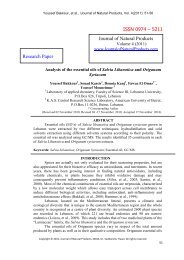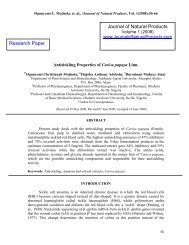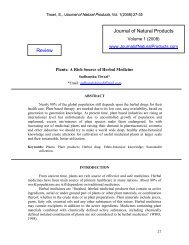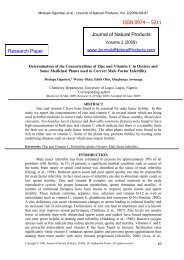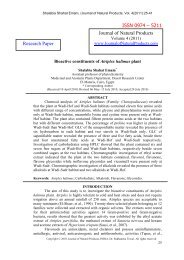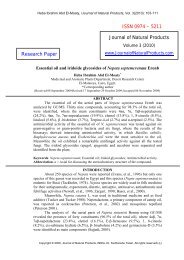Dipeptidyl Peptidase IV Inhibitory Activity Of Mangifera indica
Dipeptidyl Peptidase IV Inhibitory Activity Of Mangifera indica
Dipeptidyl Peptidase IV Inhibitory Activity Of Mangifera indica
Create successful ePaper yourself
Turn your PDF publications into a flip-book with our unique Google optimized e-Paper software.
S. Yogisha, K. A. Raveesha, /Journal of Natural Products, Vol. 3(2010):76-79<br />
ISSN 0974 – 5211<br />
Research Paper<br />
Journal of Natural Products<br />
Volume 3 (2010)<br />
www.JournalofNaturalProducts.com<br />
<strong>Dipeptidyl</strong> <strong>Peptidase</strong> <strong>IV</strong> inhibitory activity of <strong>Mangifera</strong> <strong>indica</strong><br />
Shivanna Yogisha*, Koteshwara Anandarao Raveesha<br />
Microbiology Laboratory, Department of Studies in Botany, Manasagangotri,<br />
Mysore-570006, Karnataka, India<br />
*Corresponding author<br />
(Received 24 June 2009; Revised 26 June-07 September 2009; Accepted 08 September 2009)<br />
ABSTRACT<br />
The insulinotropic hormone, glucagon-like peptide 1 (GLP-1), which has been<br />
proposed as a new treatment for type 2 diabetes, is metabolized extremely by<br />
<strong>Dipeptidyl</strong> peptidase <strong>IV</strong> (DPP-<strong>IV</strong>). Inhibitors of DPP <strong>IV</strong> enhance the level of GLP-1,<br />
which have improved glucose tolerance and increased insulin secretion. To understand<br />
the therapeutic activity of <strong>Mangifera</strong> <strong>indica</strong> for the treatment of non-insulin dependent<br />
diabetes mellitus (NIDDM). The methanolic extract of <strong>Mangifera</strong> <strong>indica</strong> leaves were<br />
tested in-vitro for DPP<strong>IV</strong> inhibitory activity. The extract showed potent activity with an<br />
IC 50 value of 182.7μg/ml. Diprotin-A was used as reference standard. The results<br />
confirm the inhibitory effect of M. <strong>indica</strong> on DPP<strong>IV</strong>, and the potential to be a novel,<br />
efficient and tolerable approach for the diabetes.<br />
Keywords: GLP-1; DPP<strong>IV</strong>; NIDDM; Diprotin-A; In-vitro.<br />
INTRODUCTION<br />
A novel approach for treatment of type- 2 diabetes is based on the gut hormone<br />
glucagon-like peptide-1 (GLP-1), which is ant-diabetic due to its combined action to<br />
stimulate insulin secretion, increase beta-cell mass, inhibit glucagon secretion, reduce<br />
the rate of gastric emptying and induces satiety. The peptide is rapidly inactivated by<br />
the enzyme dipeptidyl peptidase-<strong>IV</strong> (DPP-4), resulting in a half-life of active GLP-1 of<br />
only approximately 1-2 minutes.<br />
Inhibition of DPP-<strong>IV</strong> increases the levels of endogenous active GLP-1 and prolongs its<br />
half-life. The studies on animals showed genetic deletion of DPP-<strong>IV</strong>, which have<br />
improved glucose tolerance and increased insulin secretion in response to oral glucose.<br />
Recent studies in subjects with type 2 diabetes have shown that prolonged DPP-<strong>IV</strong><br />
inhibition for up to 1 year is anti-diabetogenic because fasting and postprandial glucose<br />
as well as HbA1c levels are reduced. Hence, DPP-<strong>IV</strong> inhibition has the potential to be a<br />
novel, efficient and tolerable approach to treat type 2 diabetes (Mentlein, 1999 and Bo<br />
Ahrén, 2005).<br />
<strong>Mangifera</strong> <strong>indica</strong> L. (Family-Anacardiaceae) is one of the most popular of all<br />
tropical fruits. Most parts of the tree [Fruit, seeds, pulp, stem bark, roots and leaves]<br />
have medicinal properties (Sathyavathi, et al., 1987). It is native to tropical Asia and<br />
Copyright © 2009, Journal of Natural Products, INDIA, Dr. Sudhanshu Tiwari, All rights reserved 76
S. Yogisha, K. A. Raveesha, /Journal of Natural Products, Vol. 3(2010):76-79<br />
has been cultivated in the Indian subcontinent for over 4000 years and is now found<br />
naturalized in most tropical countries. <strong>Mangifera</strong> <strong>indica</strong> contains vitamins A and C, β-<br />
carotene, xanthophylls, humulene, elemene, indicine, terpinine, tannins, flavonoids,<br />
linalool, nerol, gallic acid, ethyl gallate, methyl gallate & mangiferin (Aderibigbe, et al.,<br />
1999 and Wagner, 1996).<br />
The leaves of <strong>Mangifera</strong> <strong>indica</strong> were assessed for antidiabetic properties using<br />
normoglycaemic, glucose-induced hyperglycemia and streptozotocin (STZ) induced<br />
diabetic mice (Umezawa, et al., 1984). This experiment designed to evaluate the antidiabetic<br />
property of <strong>Mangifera</strong> <strong>indica</strong> leaves on DPP<strong>IV</strong> inhibitory activity. The aims of<br />
this study were to clarify methanolic extract <strong>Mangifera</strong> <strong>indica</strong> leaves inhibits DPP<strong>IV</strong> to<br />
determine inhibitory activities and to compare these activites in Diprotin, a reference<br />
standard. The present study explains one of the targets for diabetes and it helps in<br />
improved glucose tolerance and insulin secretion.<br />
MATERIALS AND METHODS<br />
Chemicals used: DPP<strong>IV</strong> from porcine kidney, Gly-pro-p-nitroanilide, Diprotein-A (Ilepro-ile),<br />
Tris-HCl Buffer. All chemicals were purchased from M/s Sigma, St Louis,<br />
USA.<br />
Sample preparation: Fresh leaves of <strong>Mangifera</strong> <strong>indica</strong> L. (Anacardiaceae) were<br />
collected from Bangalore in November 2007 and the sample was authenticated<br />
[Reference no.MI/PRO/04/07]. The powdered plant materials of 600 g were extracted<br />
with methanol using Soxhlet apparatus. The resulting extracts were evaporated in<br />
vacuum and finally lyophilized into solid mass devoid of solvent (Yield = 20 %) and<br />
stored in desiccators for future use.<br />
<strong>Dipeptidyl</strong> peptidase <strong>IV</strong> assays (in-vitro): The assay was performed as per Kojima et<br />
al (7). In brief, the assay was performed in 96 micro well plates. A pre-incubation<br />
volume 250µl contained 100mM Tris HCl buffer pH 8.4, 7.5µl of DPP <strong>IV</strong> enzyme<br />
(0.2U/ml) and various concentration of test material/reference inhibitor. This mixture<br />
was incubated at 37°C for 30mins, followed by addition of 10µl of 1.4 mM Gly-pro-pnitroanilide<br />
(substrate). The reaction mixture was incubated for 30 mins at 37°C and<br />
absorbance was measured at 410nm. Diprotein-A (Ile-Pro-Ile) was used as reference<br />
inhibitor (7).<br />
Statistical Analysis: All data are expressed as the mean ± SEM. The Statistical data<br />
were evaluated by using Graph pad Prism4 software. The % inhibition was calculated<br />
using the formula, control – test/control x 100. The IC 50 value was determined by nonlinear<br />
regression curve fit using Graph pad Prism4.<br />
RESULTS<br />
The methanolic extract of <strong>Mangifera</strong> <strong>indica</strong> leaves were tested in <strong>Dipeptidyl</strong><br />
peptidase <strong>IV</strong> inhibitory assay (in-vitro). A rapid and simple micro dilution technique on<br />
96-well micro plate based on enzyme inhibition mechanism was optimized and<br />
validated for screening of antidiabteic activity.<br />
The highest concentration tested for the <strong>Mangifera</strong> <strong>indica</strong> in DPP<strong>IV</strong> assay was<br />
320μg/ml. The 50% inhibition was exhibited at 160μg/ml. <strong>Mangifera</strong> <strong>indica</strong> leaves<br />
methanolic extract inhibited porcine kidney DPP-<strong>IV</strong> with an IC 50 of 182.7μg/ml. The<br />
data pertaining to the antidaibetic potential of the <strong>Mangifera</strong> <strong>indica</strong> leaves are presented<br />
in Table 1 & Fig 1 respectively. The 95% confidence interval <strong>indica</strong>tes the IC 50 value<br />
was found to be within the range of tested concentration.<br />
Copyright © 2009, Journal of Natural Products, INDIA, Dr. Sudhanshu Tiwari, All rights reserved 77
S. Yogisha, K. A. Raveesha, /Journal of Natural Products, Vol. 3(2010):76-79<br />
Table-1: DPP<strong>IV</strong> inhibitory activity of <strong>Mangifera</strong> <strong>indica</strong> & Diprotin A.<br />
S. No. Tested material Concentration<br />
μg/ml<br />
% inhibition ±<br />
S.E.M<br />
0 1.12 ± 1.10<br />
5 9.47 ± 1.20<br />
1 <strong>Mangifera</strong> <strong>indica</strong><br />
10 14.22 ± 1.50<br />
(n=3)<br />
20 27.44 ± 0.45<br />
40 39.55 ± 0.80<br />
80 48.12 ± 1.10<br />
160 49.22 ± 1.64<br />
320 68.22 ± 1.14<br />
2 Diprotin-A (n=3)<br />
(Ile-Pro-Ile)<br />
positive control<br />
0 1.21 ± 1.20<br />
2.5 13.75 ± 2.34<br />
5 22.71± 1.34<br />
10 41.72 ± 1.67<br />
20 62.57 ± 1.74<br />
30 67.88 ± 1.80<br />
40 73.83 ± 0.94<br />
IC50 (μg/ml)<br />
(95% C.I) a<br />
182.7<br />
(82.35-284.61)<br />
19.71<br />
(9.7-32.79)<br />
Figure-1<br />
DISCUSSION<br />
GLP-1 is a substrate for the enzyme <strong>Dipeptidyl</strong> peptidase <strong>IV</strong> (DPP-<strong>IV</strong>), a serine<br />
protease which degrades GLP-1 into its inactive form. Exogenous GLP-1<br />
administration has been shown to be useful in the treatment of type 2 diabetes.<br />
However, the short half-life makes GLP-1 unattractive for chronic therapy of type 2<br />
diabetes. DPP-<strong>IV</strong> inhibition is an approach to prolong the circulating half-life of<br />
GLP-1, thus making DPP-<strong>IV</strong> inhibitors a promising target for the treatment of type 2<br />
diabetes.<br />
<strong>Dipeptidyl</strong> peptidase-<strong>IV</strong> (DPP-<strong>IV</strong>) is involved in the inactivation of glucagonlike<br />
peptide-1 (GLP-1), a potent insulinotropic peptide. Thus, DPP-<strong>IV</strong> inhibition can be<br />
an effective approach to treat type 2 diabetes mellitus by potentiating insulin secretion<br />
(Umezawa, et al., 1984 & Aderibigbe, et al., 2001).This study describes the biological<br />
effects of a natural plant extracts <strong>Mangifera</strong> <strong>indica</strong> in-vitro. In addition, the M. <strong>indica</strong><br />
methanolic extract inhibited DPP-<strong>IV</strong> mediated degradation of GLP-1 in- vitro. M.<br />
Copyright © 2009, Journal of Natural Products, INDIA, Dr. Sudhanshu Tiwari, All rights reserved 78
S. Yogisha, K. A. Raveesha, /Journal of Natural Products, Vol. 3(2010):76-79<br />
<strong>indica</strong> methanolic extract exhibited competitive type of enzyme inhibition. The antidiabetic<br />
property of <strong>Mangifera</strong> <strong>indica</strong> leaves makes this study unique (Wagner, 1996).<br />
The result explains inhibitory activities on DPP <strong>IV</strong> and may have therapeutic potential<br />
on type 2 diabetes.<br />
The present study underlines that <strong>Mangifera</strong> <strong>indica</strong> inhibits the DPP<strong>IV</strong> and<br />
enhances the GLP-1 for type 2 diabetes. This study demonstrates that <strong>Mangifera</strong> <strong>indica</strong><br />
methanolic leaves extract could be a good lead for further development as a new antidiabetic<br />
agent.<br />
Acknowledgements: The authors are grateful to Department of Studies in Microbiology &<br />
Botany for providing facilities.<br />
REFERENCES<br />
Mentlein, R., (1999): <strong>Dipeptidyl</strong>-peptidase <strong>IV</strong> (CD26): Role in the inactivation of regulatory<br />
peptides. Regulatory Peptides, 24:85-89.<br />
Bo Ahrén., (2005): Inhibition of <strong>Dipeptidyl</strong> <strong>Peptidase</strong>-4 (DPP-4): A Novel Approach to treat<br />
type 2diabetes. Current Enzyme Inhibition, 1:65-73.<br />
Umezawa, H., Aoyagi, H., Ogawa, K., (1984): Diprotein A and B, inhibitors of <strong>Dipeptidyl</strong><br />
amino peptidase <strong>IV</strong>, produced by Bacteria. The Journal of Antibiotics, 26:422-425.<br />
Sathyavathi, G.V., Gupta, A.K., Tandon, N., (1987): Medicinal plants of India, Indian<br />
Council of Medical Research, New Delhi, India. pp. 209-212.<br />
Aderibigbe, A.O., Emudianughe, T.S., Lawal, B.A., (1999): Antihyperglycaemic effect of<br />
<strong>Mangifera</strong> <strong>indica</strong> in rat. Phytotherapy Research., 13:504-507.<br />
Wagner, H., Bladt, S., (1996): Plant Drug Analysis, Springer Verlag, 2 nd edition, Germany.<br />
Kojima, K., Ham, T., Kato, T., (1980): Rapid chromatographic purification of <strong>Dipeptidyl</strong><br />
peptidase <strong>IV</strong> in human submaxiallry gland. Journal of Chromatography, 189:233-240.<br />
Umezawa, H., Aoyagi, H., Ogawa, K., (1984): Diprotein A and B, inhibitors of <strong>Dipeptidyl</strong><br />
amino peptidase <strong>IV</strong>, produced by Bacteria. The Journal of Antibiotics, 26:422-425.<br />
Aderibigbe, A.O., Emudianughe, T.S., Lawal, B.A., (2001): Evaluation of the antidiabetic<br />
action of <strong>Mangifera</strong> <strong>indica</strong> in mice. Phytotherapy Research., 5: 456-458.<br />
Copyright © 2009, Journal of Natural Products, INDIA, Dr. Sudhanshu Tiwari, All rights reserved 79



